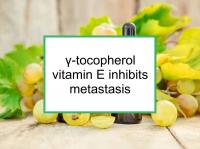Vitamin E is the collective name for a group of eight related vitamins, including four tocopherols (α, β, γ, and δ-tocopherol) and four tocotrienols (α, β, γ, and δ-tocotrienol). The eight variants have somewhat different biological activities. Alpha-tocopherol (α-tocopherol) is the isoform typically found in vitamin E supplements.
Even brands containing mixed tocopherols do not contain any tocotrienols. However, evidence is accumulating that gamma-tocotrienol (γ-tocotrienol) is most effective in suppressing the proliferation of both hormone receptor positive (ER+/PR+) and triple negative (ER-/PR-/HER2-) breast cancer cells, as well as inducing their apoptosis (programmed cell death). Now a new study has reported that gamma-tocotrienol inhibits crucial steps in metastasis in a dose-response manner in both ER+/PR+ and triple negative cells.
Vitamin E supplements and breast cancer
Several studies have reported that women who regularly take vitamin E supplements after being diagnosed with breast cancer are somewhat more likely to survive than those who do not, but the link is not strong. There is also some evidence that taking vitamin E supplements increases the risk of breast cancer for women who are not deficient and may interfere with breast cancer treatment. For example, vitamin E supplements have been reported to reduce the treatment effects of tamoxifen. In addition, palm oil (an abundant source of tocotrienols) has been shown to protect tumor cells treated with doxorubicin from cell death.
Food sources of gamma-tocotrienol
Gamma-tocotrienol is found most abundantly in crude palm oil, however the high saturated fat content of this oil makes it undesirable for frequent use. Camelina oil, grape seed oil, rice bran and rice bran oil are very good sources. Modest amounts of gamma-tocotrienol are also found in barley, oats, rye and corn, as well as coconut oil.
Gamma-tocotrienol and breast cancer
One study found that palm oil vitamin E demonstrated higher antiproliferative and anti-inflammatory effects in both ER+/PR+ and triple negative breast cancer cells than other palm oil phytonutrients, including various carotenoids, squalene and co-enzyme Q10 (CoQ10). Another study using a mouse model of breast cancer reported that gamma-tocotrienol given as part of the diet suppressed tumor growth. The same study also reported that gamma-tocotrienol inhibited colony formation of both mouse mammary and human breast cancer cell lines. Colony formation refers to the ability of a single cell to grow into a colony consisting of at least 50 cells. Colony formation assay is used to measure the effects of cytotoxic compounds on cancer cells in the laboratory.
Still another study reported different effects for alpha-tocopherol and gamma-tocopherol in combination with docosahexaenoic acid (DHA) (found in the fatty fish and fish oil supplements) in triple negative breast cancer cells. DHA alone was shown to induce apoptosis, as expected. The addition of gamma-tocotrienol increased apoptotic events in the cells. However, alpha-tocopherol blocked DHA-induced apoptosis.
Latest research finds gamma-tocotrienol suppresses metastasis
The study referenced at the beginning of this news story was designed to investigate the mechanism of action by which gamma-tocotrienol inhibits the epithelial-to-mesenchymal cell transition (EMT) in breast cancer cells, in particular, the impact of gamma-tocotrienol on the canonical Wnt pathway. The Wnt signaling pathway activates the MET that cancer cells undergo in the process of becoming capable of metastasis. An EMT enables an epithelial cell to undergo a variety of changes that enable it to assume a mesenchymal cell phenotype, thereby acquiring enhanced migratory capacity and invasiveness, as well as elevated resistance to apoptosis. Inhibition of Wnt signaling appears to play a central role in the anticancer activity of some micronutrients.
To conduct the study, the authors maintained triple negative (MDA-MB-231), ER+/PR+ (T-47D) and immortalized normal breast epithelial (MCF-10A) cells in media containing various doses of gamma-tocotrienol. Cell viability, protein expression, and cell mobility and migration were measured. In addition, specialized staining was used to locate and visualize cellular EMT markers. Gamma-tocotrienol was found to cause inhibition of MDA-MB-231 and T-47D cell growth in a dose-response manner. The doses used had no effect on normal cells. The inhibition of growth was found to be associated with suppression of canonical Wnt signaling, reversal of EMT, and substantial reductions in breast cancer cell motility (the ability to move, which is required for metastasis). The authors conclude that gamma-tocotrienol suppresses metastatic breast cancer cell proliferation and EMT through suppression of the canonical Wnt signaling pathway.
